The Snapdragon 855 Performance Preview: Setting the Stage for Flagship Android 2019
by Andrei Frumusanu on January 15, 2019 8:00 AM EST- Posted in
- Mobile
- Qualcomm
- Smartphones
- SoCs
- 7nm
- Snapdragon 855
Inference Performance: Good, But Missing Tensor APIs
Beyond CPU and GPU, the one aspect of the Snapdragon 855 that Qualcomm made a lot of noise about is the new Hexagon 690 accelerator block.
The new unit doubles its vector pipelines, essentially doubling performance for traditional image processing tasks as well as machine inferencing workloads. Most importantly, Qualcomm now includes a dedicated “Tensor Accelerator” block which promises to even better offload inferencing tasks.
I’ve queried Qualcomm about the new Tensor Accelerator, and got some interesting answers. First of all- Qualcomm isn’t willing to disclose more about the performance of this IP block; the company had advertised a total of “7 TOPS” computing power on the part of the platform, but they would not dissect this figure and attribute it individually to each IP block.
What was actually most surprising however was the API situation for the new Tensor accelerator. Unfortunately, the block will not be exposed to the NNAPI until sometime later in the year for Android Q, and for the time being the accelerator is only exposed via in-house frameworks. What this means is that none of our very limited set of “AI” benchmarks is able to actually test the Tensor block, and most of what we’re going to see in terms of results are merely improvements on the side of the Hexagon’s vector cores.
Inference Performance
First off, we start off with “AiBenchmark” – we first starred the new workload in our Mate 20 review, to quote myself:
“AI-Benchmark” is a new tool developed by Andrey Ignatov from the Computer Vision Lab at ETH Zürich in Switzerland. The new benchmark application, is as far as I’m aware, one of the first to make extensive use of Android’s new NNAPI, rather than relying on each SoC vendor’s own SDK tools and APIs. This is an important distinction to AIMark, as AI-Benchmark should be better able to accurately represent the resulting NN performance as expected from an application which uses the NNAPI.
Andrey extensive documents the workloads such as the NN models used as well as what their function is, and has also published a paper on his methods and findings.
One thing to keep in mind, is that the NNAPI isn’t just some universal translation layer that is able to magically run a neural network model on an NPU, but the API as well as the SoC vendor’s underlying driver must be able to support the exposed functions and be able to run this on the IP block. The distinction here lies between models which use features that are to date not yet supported by the NNAPI, and thus have to fall back to a CPU implementation, and models which can be hardware accelerated and operate on quantized INT8 or FP16 data. There’s also models relying on FP32 data, and here again depending on the underlying driver this can be either run on the CPU or for example on the GPU.

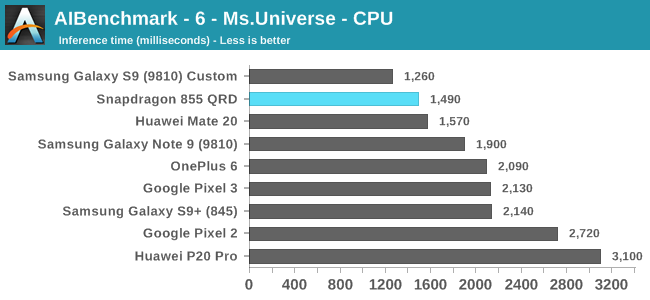
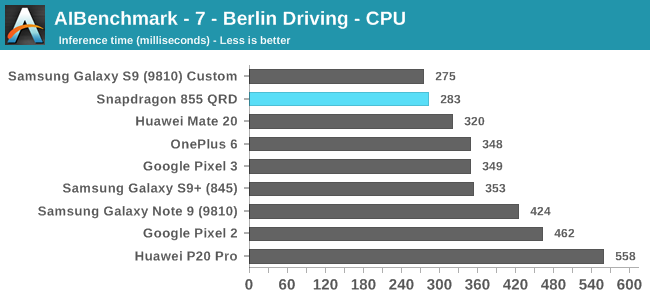
In the first set of workloads which I’ve categorised by being run on the CPU, we see the Snapdragon 855 perform well, although it’s not exactly extraordinary. Performance here is much more impacted by the scheduler of the system and exactly how fast the CPU is allowed to get to its maximum operating performance point, as the workload is of a short burst nature.
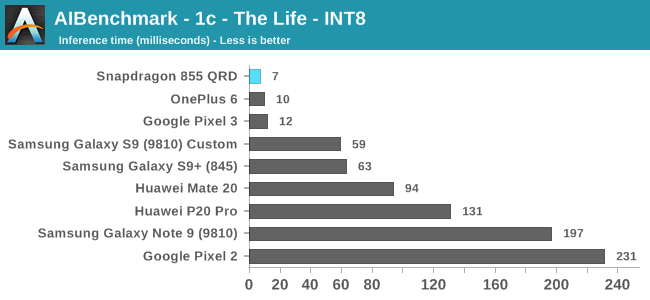
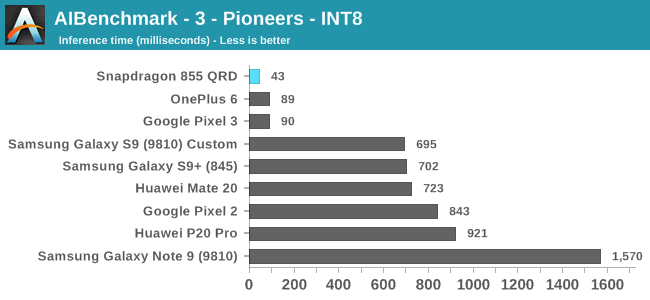
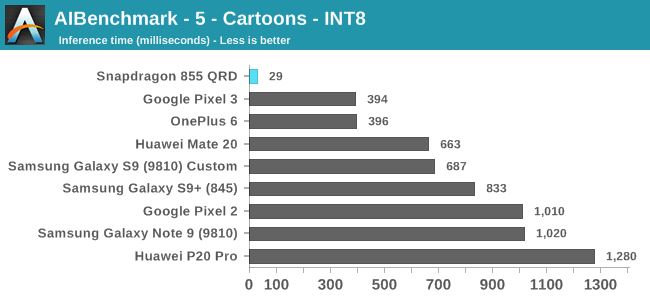
Moving onto the 8-bit integer quantised models, these are for most devices hardware accelerated. The Snapdragon 855’s performance here is leading in all benchmarks. In the Pioneers benchmark we more clearly see the doubling of the performance of the HVX units as the new hardware posts inference times little under half the time of the Snapdragon 845.
The Cartoons benchmark here is interesting as it showcases the API and driver aspect of NNAPI benchmarks: The Snapdragon 855 here seems to have massively better acceleration compared to its predecessors and competing devices. It might be that Qualcomm has notably improved its drivers here and is much better able to take advantage of the hardware, compared to the past chipset.
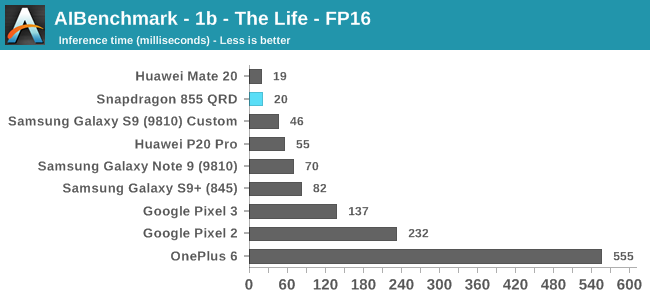
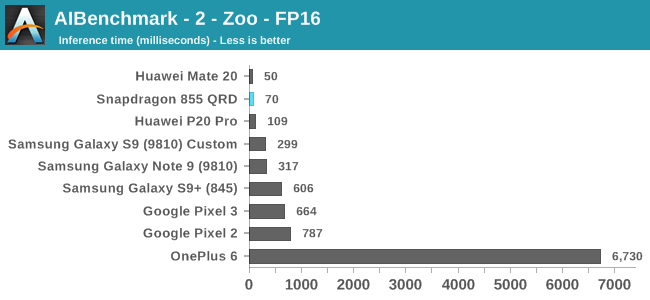
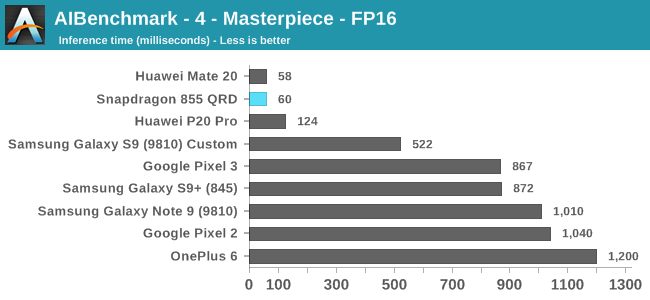
The FP16 workloads finally see some competition for Qualcomm as the Kirin’s NPU exposes support for its hardware here. Qualcomm should be running these workloads on the GPU, and here we see massive gains as the new platform’s NNAPI capability is much more mature.
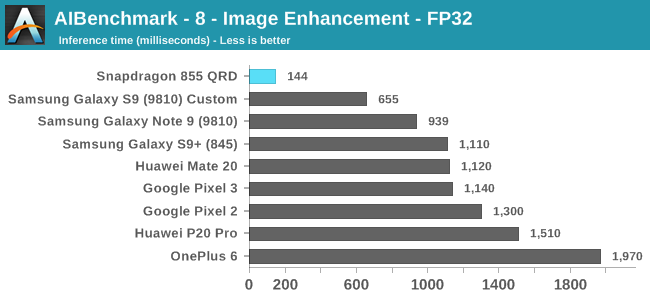
The FP32 workload sees a similar improvement for the Snapdragon 855; here Qualcomm finally is able to take full advantage of GPU acceleration which gives the new chipset a considerable lead.
AIMark
Alongside AIBenchmark, it still might be useful to have comparisons with AIMark. This benchmark rather than using NNAPI, uses Qualcomm’s SNPE framework for acceleration. Also this gives us a rare comparison against Apple’s iPhones where the benchmark makes use of CoreML for acceleration.
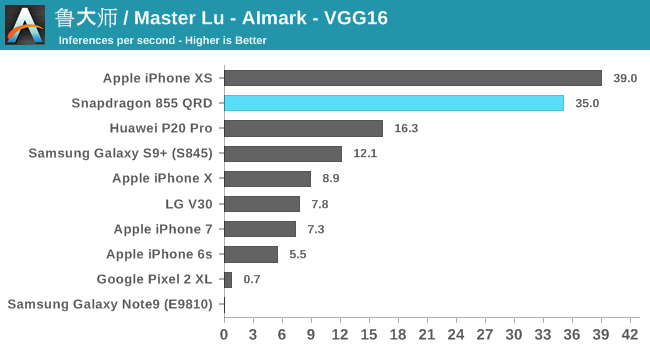
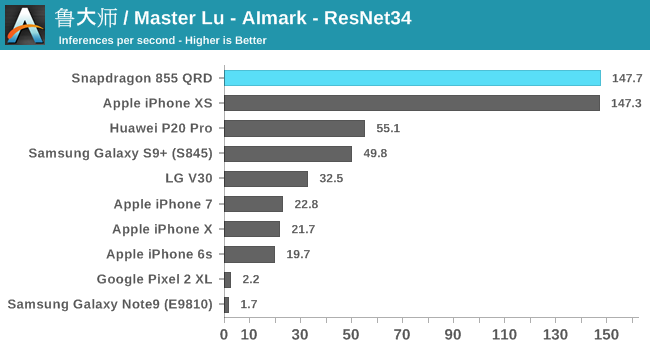
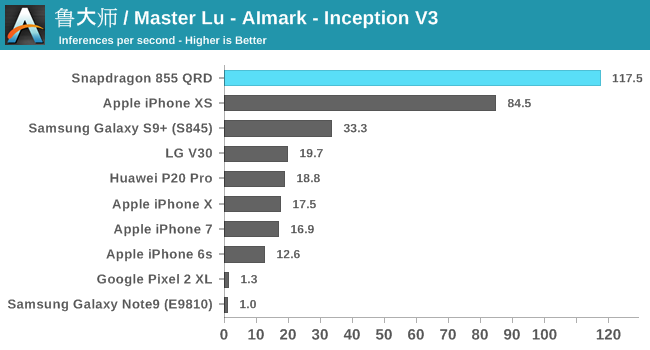
Overall, the Snapdragon 855 is able to post 2.5-3x performance boosts over the Snapdragon 845.
At the event, Qualcomm also showcased an in-house benchmark running InceptionV3 which was accelerated by both the HVX units as well as the new Tensor block. Here the phone was able to achieve 148 inferences/s – which although maybe apples to oranges, represents a 26% boost compared to the same model run in AIMark.
Overall, even though the Tensor accelerator wasn’t directly tested in today’s benchmark results, the Snapdragon 855’s inference performance is outstanding due to the overall much improved driver stack as well as the doubling of the Hexagon’s vector execution units. It will be interesting to see what vendors do with this performance and we should definitely see some exciting camera applications in the future.


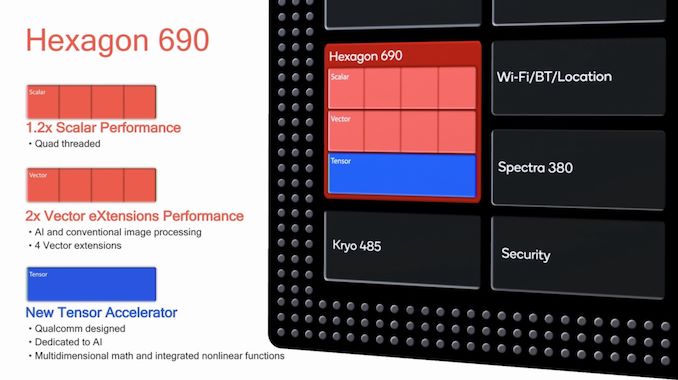








132 Comments
View All Comments
tipoo - Tuesday, January 15, 2019 - link
Untrue. Apples cores are wider, deeper, more OoO than anything else in mobile, and use massive caches at that. You have it reversed, if Android could use the A12 it would post impressive benchmarks, it's hardware design.Low level benchmarks are meant to remove the OS from the equation. Proof is in the pudding.
goatfajitas - Tuesday, January 15, 2019 - link
The A12 is a great CPU, but it's not magic. It's all ARM. The difference is in the implementation and control that Apple has with integration. Whatever though, both ways have benefits and downsides. I am just saying that people that think it's all about this CPU that is somehow years ahead of everyone else are mistaken as to the reality of the situation. Suffice to say, it's all fast.axius81 - Tuesday, January 15, 2019 - link
This just doesn't make sense. "It's all ARM." Yeah, sure, and one companies implementation of that instruction set can absolutely be superior.That's like saying "It's all x86 / x86-64." when we're comparing AMD and Intel. One can *absolutely* be faster than the other at implementing that instruction set - and in practice, is.
Apple makes amazing ARM chips, irrespective of iOS.
goatfajitas - Tuesday, January 15, 2019 - link
They are great chips, I am just saying they are not (hardware wise) way beyond what the competition is doing. Alot of that performance is OS, tight integration with apps, drivers, API's etc as its all controlled by one company. That isnt a bad thing, that is a good thing for Apple customers.techconc - Tuesday, January 15, 2019 - link
Actually, Apple is significantly ahead of what the competition is doing with ARM based chips. This can be objectively measured.tipoo - Wednesday, January 16, 2019 - link
What do you call their massive cache and issue width advantage if not being hardware wise beyond the competition? It's not magic, but Apple is clearly spending more on die area than Qualcomm is.bji - Tuesday, January 15, 2019 - link
Yeah I don't think you know what you're talking about. I think you read somewhere that some of Apple's performance/stability superiority over Android come from Apple controlling the whole stack and you've generalized that into places where the statement just isn't true.techconc - Tuesday, January 15, 2019 - link
You seem to conflate the ARM instruction set with the actual design of the chip. You then play off Apple's obvious advantages as some sort of magic... err.. "integration" as you call it. That's nonsense. You might be able to claim that for a specific application, but not for generic benchmarks.tipoo - Wednesday, January 16, 2019 - link
I didn't say it was magic. I said it's not entirely down to some ambiguous "optimization" with the OS. The cores themselves are physically impressive regardless of OS."It's all ARM."
This shows me you may have missed crucial step, Apple is only licencing the ARM instruction set, but otherwise they design the whole very wide, deep, very OoO core themselves.
tipoo - Wednesday, January 16, 2019 - link
I didn't say it was magic. I said it's not entirely down to some ambiguous "optimization" with the OS. The cores themselves are physically impressive regardless of OS. It's when people play it off as some pie in the sky optimization advantage that they're claiming magic, you can't make a 3-wide Braswell core fly just with vertical integration."It's all ARM."
This shows me you may have missed crucial step, Apple is only licencing the ARM instruction set, but otherwise they design the whole very wide, deep, very OoO core themselves.